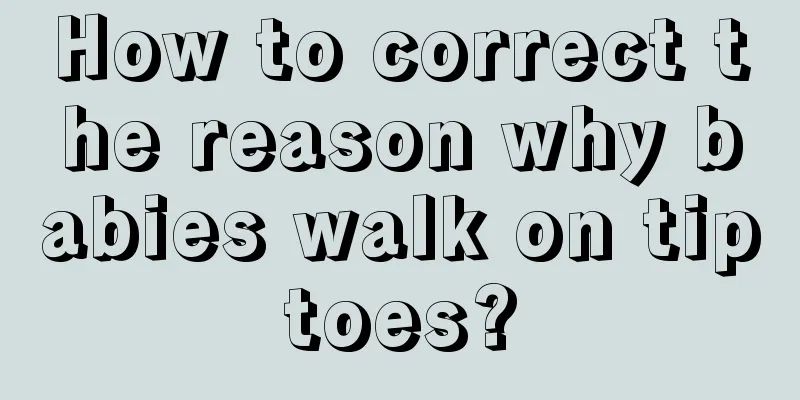How to correct the reason why babies walk on tiptoes?

|
Many babies walk on tiptoe when they first learn to walk, which makes mothers very anxious. They are especially afraid that it will have a bad impact on the baby's growth and development. They are also worried that the baby will continue to walk like this in the future and affect the appearance. Parents don't have to worry, the editor will teach you a few tricks to correct your baby's tiptoe walking. How to correct a baby's tiptoe walking1. Slowly pull up to sit Babies who often lie on their stomachs learn to crawl, sit and walk faster. If they are not learning to crawl yet, you can let them lie on their stomachs more often. In addition, if the baby is lying on the bed, you can use your hands to gently pull him up to sit (like doing sit-ups), which can exercise the neck muscles and the muscles of the upper body. (Don't use too much force) 2. Roll on the bed Put your baby in the middle of the bed, accompany him, encourage him, and let him roll around on the bed more, which can also train his muscles and make him stronger. Play more games with him to get him used to the feeling of moving his hands and feet. 3. Stretch your legs Hold the baby's armpits with both hands, lift the baby up, and let him do kicking and jumping movements to practice the baby's leg stretching ability. 4. Climb, climb, climb When your baby can stand, you can train him to walk simply. Put some of his favorite toys on a sofa or coffee table that is about his height, and encourage him to stand up. 5. Practice standing with your hands free Babies who are just learning to walk will definitely be afraid to let go and stand. Parents can use some toys that he likes to guide him, and then let go unconsciously. (Pay attention to safety protection) 6. Assisted walking training Babies learning to walk often walk slowly by holding on to the wall, sofa, coffee table, crib, stroller, chair, etc. Mom and dad can follow behind the baby and watch him walk; they can also hold the baby's arm to assist him in walking, and then slowly transition until he can walk with one hand holding the arm. 7. Train your baby to walk more often When your baby starts to be interested in walking, don't hold him often, but let him try more. At first, you can squat in front of the baby and use toys to guide him. When the baby comes over, then step back a little. When the baby is more proficient in walking, you can squat in front and behind the baby and use his favorite toys to guide him to walk back and forth. Comfort the baby after he falls! Reasons for walking on tiptoesWalking on tiptoes is medically called "pointe gait", or "pointe feet" for short. It can be divided into physiological and pathological types, that is, normal and abnormal. 1. Physiological pointed feet Babies in the toddler stage often have tight leg muscles, their center of gravity is forward when walking, their body coordination is not good, and their feet lack the sense of contact with the ground, so they walk on tiptoes. The phenomenon of walking on tiptoes generally disappears with growth and development. If the baby under 2 years old only walks on tiptoes occasionally, there is no need to worry. However, a small number of babies walk on tiptoes because of abnormal leg development and short Achilles tendons. In this case, mild cases can be corrected through muscle training, but severe cases require consultation with a professional doctor. 2. Pathological pointed feet If it is pathological pointed feet, there may be a certain degree of brain damage or abnormal brain development. After learning to stand alone or squatting, they often stand on their toes, and walk on tiptoes frequently. They often walk on tiptoes even after they are over two years old. At the same time, there is a sensory disorder: simply put, the visual and auditory response is not sensitive. In this case, parents should take the baby to the hospital for examination. Is walking on tiptoes a sign of cerebral palsy?Liang Song, director of the hospital's Children's Brain Disease Rehabilitation Center, said that it is normal for babies to occasionally walk on tiptoes when learning to walk. This may be due to curiosity or wearing inappropriate shoes. Some parents may adjust the height of the walker they use for their babies inappropriately, which will cause the baby's center of gravity to lean forward when walking and develop the habit of walking on tiptoes. These situations will gradually return to normal. It is not scientific to say that babies who like to walk on tiptoes when learning to walk are a precursor to cerebral palsy. "Parents do not need to worry too much when their baby is learning to walk on tiptoes, but they should not take it lightly and need to observe carefully." Liang Song reminded that if the baby's tiptoe walking condition persists for a long time, especially if the baby keeps tiptoeing from learning to stand to learning to walk, it may be that the baby has high muscle tone and limb movement disorders, and it is necessary to be alert to cerebral palsy. If the baby's tiptoe walking condition persists for a long time and is accompanied by developmental delays, poor visual and auditory response, etc., it should be taken to the hospital for examination in time. If a child still walks on tiptoes after the age of 2, he needs to see a doctorHowever, if the baby walks on tiptoes for more than a few months, or after 2-3 years old, the baby still walks on tiptoes, parents need to pay more attention. First, check whether the baby's shoes are suitable and whether the shoes are causing discomfort. When learning to walk at home, it is best not to wear shoes, which is better for the development of the baby's feet. When you need shoes to protect yourself when going out, choose comfortable and non-slip shoes to help your baby walk more steadily and better. In addition, don't forget that babies' feet grow very fast. Try the size of the shoes every month to see if there is a space of about one finger between the front toe and the front of the shoe. Shoes that are too tight will make it uncomfortable for babies to walk, so it is better not to wear them. Most babies will stop walking on tiptoes, but some will continue to do so until they are adults. This may be related to the baby's neuromuscular development, so if your baby still walks on tiptoes after the age of 2, or has other motor difficulties, it is recommended to communicate with your pediatrician for an examination to confirm whether intervention is needed. |
<<: How to regulate baby's constipation diet is the key
>>: How can a baby sleep to have a good head shape?
Recommend
Beware of the secret recipe in Legend of Miyue and pay attention to scientific pregnancy protection
Palace dramas have been very popular in recent ye...
Why is it that one eye is bigger than the other? Be alert to these four possibilities
Eyes are the most important organ in the human bo...
How is Xubeier milk powder? Which country is Xubeier milk powder from?
How much do you know about milk powder? Today, le...
How to strengthen the education of children who are impetuous and impatient? How to do psychological education for children?
The issue of children's education has always ...
Will the baby choke on water during a water birth? Will the baby not drown during a water birth?
Water birth is a way of childbirth that mothers c...
Will my milk supply decrease during my menstrual period while I am breastfeeding? What should I do if my milk supply decreases during my menstrual period while I am breastfeeding?
Will the milk supply decrease during menstruation...
What is the inulin in Qiyun pregnant milk powder? When is the best time to drink Wyeth Qiyun milk powder?
Many mothers choose Qiyun milk powder for pregnan...
How to eat crabs? What is the best way to eat crabs?
The crab season is here. How to cook the big, ten...
How can parents strengthen parent-child bonding during holidays?
In the process of growing up, sufficient interact...
What is the amniotic band? Does the appearance of the amniotic band harm pregnant women?
During pregnancy, some pregnant women will have a...
How long after taking medicine can a baby drink milk? How long after taking medicine can a baby drink milk powder?
Babies are weak and easily get sick. How to feed ...
The order and time of children's tooth replacement. How long does it take for children's teeth to grow out?
We all know that children will experience tooth r...
What are the misunderstandings about feeding babies? 5 major misunderstandings to pay attention to
Many parents will continue to feed their children...
When is the best time to apply a facial mask? When is the best time of the day to apply a facial mask?
Facial masks are something that people often use....
How to use ovulation test strips_How to use ovulation test strips
When preparing for pregnancy, you need to choose ...









